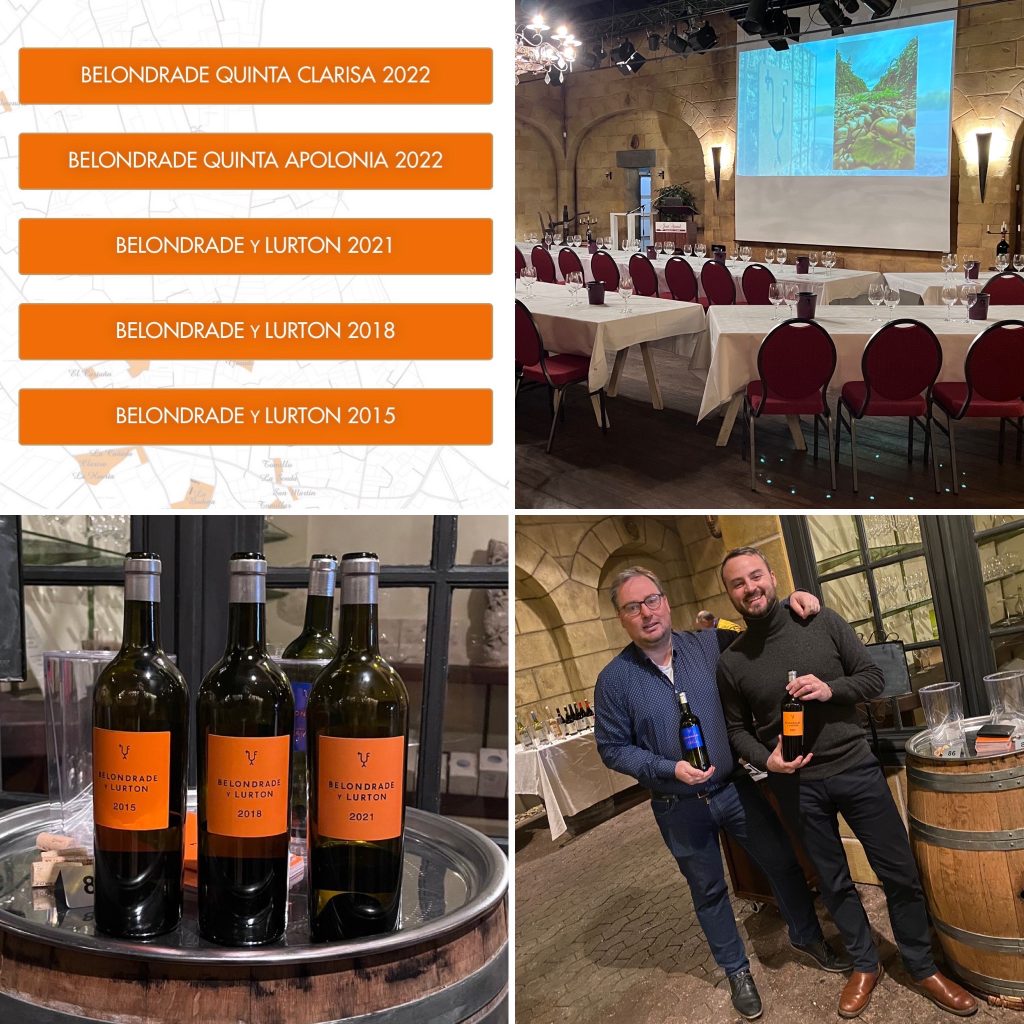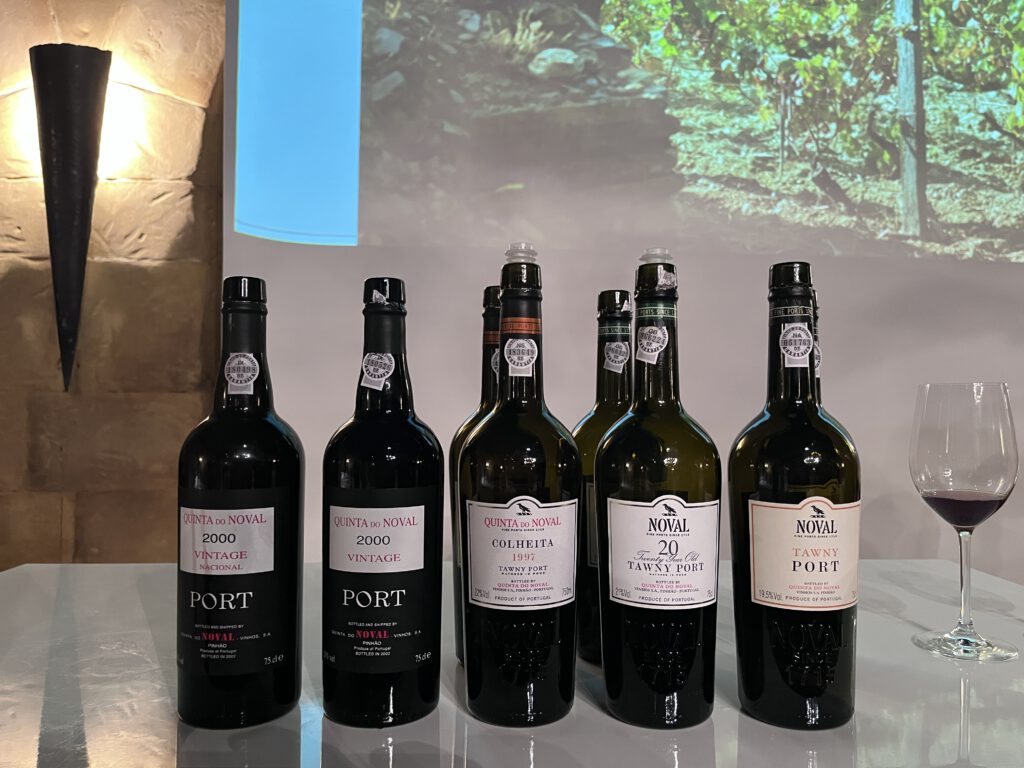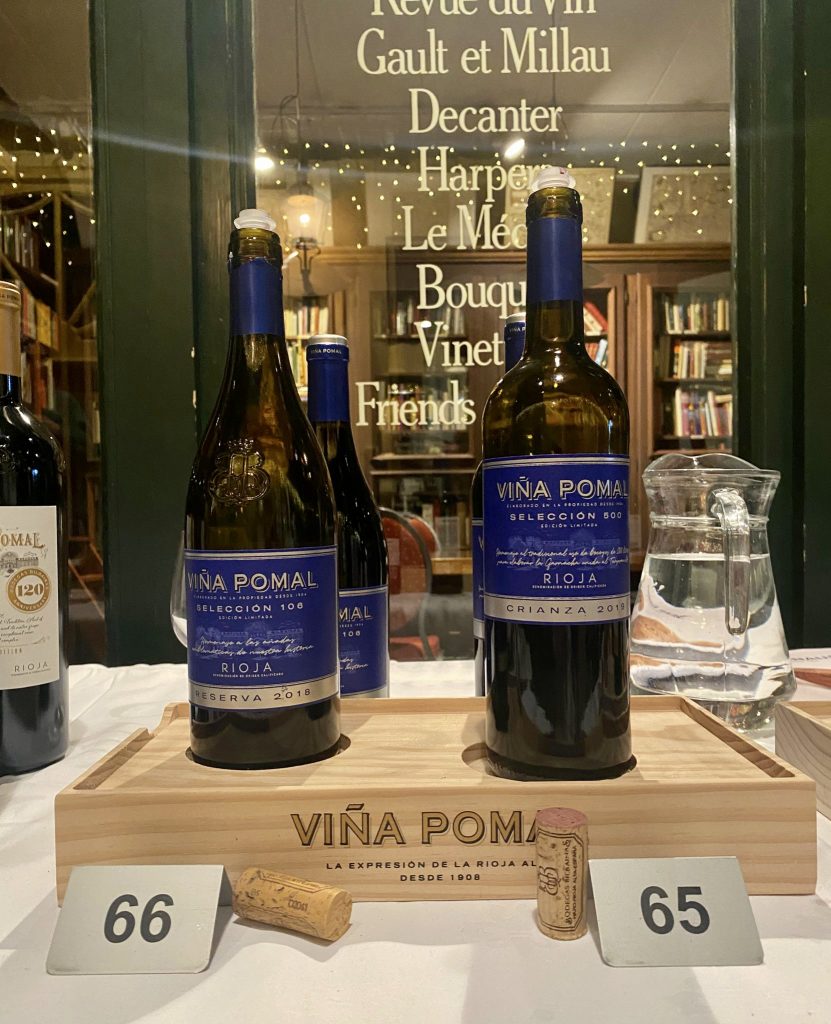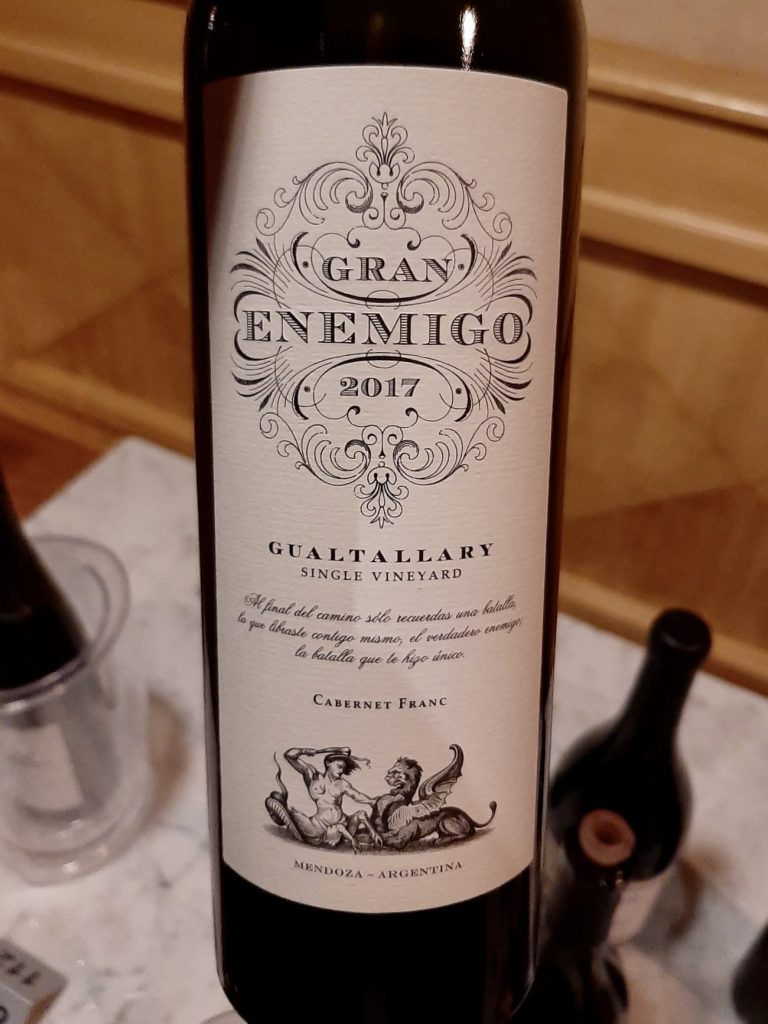Jean Arnaud Portfolio Tasting 2023.
Recently we attended the portfolio tasting of Dutch wine importer Jean Arnaud, along with a masterclass by one of the wineries they import, a personal favorite of ours: Belondrade.
This event was covered for Dutch Wine Apprentice by: Inma Muñoz, Hermen Jansen and Niels Aarts. In this article we are sharing some of the highlights we discovered and we look back at the Belondrade Masterclass.
The 5 wineries that are featured in this overview are:
- Belondrade Vinos – Rueda, Spain (HJ & NA)
- Quinto Do Noval – Douro, Portugal (HJ)
- Campo Eliseo – Rueda and Toro, Spain (IM)
- Vina Pomal – Rioja, Spain (IM)
- El Enemigo – Mendoza, Argentina (HJ)
About Jean Arnaud
Jean Arnaud has a long and successful history dating back to 1964, the year in which they started. Their wide portfolio of wines, both from old as well as new world wine regions, is sold to retailers across the Netherlands and with ‘Maison du Vin’ they also sell wine directly to consumers.
Maison du Vin is also the name of the wine museum, in which Jean Arnaud and their store are located. A great location that teaches you about wine, built in style of an authentic French village. This is also the location where the tasting and masterclasses of this event took place.
Masterclass Belondrade – Rueda, Spain
We talked about and with Belondrade a lot over the years, they frequented us as guest in our talk show and podcast and we reviewed all their wines of course. So, you could think there are not that many surprises for us when it comes to this winery. Nevertheless, we got surprised and again learned a lot from Jean Belondrade who shared the Belondrade philosophy with us. A philosophy and vision inspired by Jean’s father Didier, who still runs the winery to date, together with his son. For those who are not that familiar with the winery we will share a part of the story around Belondrade.
It is 1992 when the French couple Didier Belondrade and Brigitte Lurton tastes their first Verdejo wine. Love at first sight! Making wine and the wine business are not new to them, with roots deep in Bordeaux, but this variety and wine got them to think about a new project.
For this project they set out to find the perfect location for a winery in Spain’s Rueda D.O. Their eye falls on the village of La Seca, about 8 kilometers from the important river Douro. The climate here is dry and hot, with long cold winters and short warm summers, giving the grapes a real boost and excellent acidity. The soil consists of a deep layer of water retaining clay and an upper soil filled with stones that look similar to the big round ‘galets’ from the Rhône. Stones that also have a crucial role in the vineyards.
Their choice could not have been better because in the following years the Belondrade winery has evolved into one of the leading and most recognized white wine producers in Spain, with a prominent role for that Verdejo grape. Although the successful combination Verdejo – Rueda is discovered by others in the years that follow there something that made, and still makes, Belondrade and their wines unique and stand out. It is the work in the vineyards and cellar that carries Belondrade’s philosophy. Their French roots and knowledge certainly play a role here.
According to Jean Belondrade the circumstances for winemakers in the Rueda region are equal, the difference is made in the way the winery and winemaker approaches the potential. Didier Belondrade is convinced of the aging potential of the Verdejo grape and uses this potential in his vinification methods.

As part of the masterclass we tasted the 3 wines Belondrade produces, a rose named Clarisa and two white wines, Apolonia and Belondrade y Lurton.
Clarisa 2022 – Rose, Tempranillo and Syrah.
When the family was expanding their vineyards, they were obliged to retain a parcel of Tempranillo and Syrah, which they had to acquire along with some desired parcels of Verdejo. Although it was not really the intention to grow these grapes, and make a rose wine, Didier wanted to make something special out of it. It was decided that the grapes should end up in a rose wine in honor of his youngest daughter: Clarisa.
An interesting choice because at Belondrade they believe in the power of assemblage, and although made out of two different varieties (which is also unique for Belondrade) this is factually the only single vineyard wine they produce.
The blend consists of 75% Tempranillo and 25% Syrah, with Syrah adding some nice spices to this rose. After being fermented spontaneously there is a special touch added to the wine, it rests on the lees of some Verdejo grapes. This unique approach adds creaminess to the wine and makes it rounder.
Another technique that adds additional depth is barrel fermentation. About 10% of the wine undergoes this type of fermentation, a technique that is not strange to Belondrade and can be seen as part of the Belondrade signature.
Clarisa has a transparent ruby red color, accompanied by earthy and floral notes. On the palette a refined structure with a firm ‘core’. A long, powerful and bitter taste with soft tannins. The result is a rose wine with the soul of a red wine and structure of a white. Quite unique! DWA-score: 92/100 (NA).
Apolonia 2022 – White, Verdejo.
Apolonia also sees a reference to the Belondrade family. Its name links to the oldest daughter of the family. This wine follows the tradition of the Bordeaux Chateaux’s, who have a first and second wine which they produce. In the beginning it was difficult to sell the concept of a “second wine” in Spain but this wine has
Although Apolonia is Belondrade’s second wine it has every right to be seen on its own. Its profile and character are quite different compared to its older sibling ‘Belondrade y Lurton’. Apolonia can be seen as a reflection of the true face of Verdejo.
In the glass it shows a pale lemon color, followed by a perfumed nose that boosts citrus and stone fruit combined with spices and herbal notes. On the palette the citrus notes continu, but with some more roundness (think key lime pie) and green herbs. The aftertaste is pleasant and upbeat, with a floral character. This is a clean and straightforward wine that is refreshing but possesses surprising depth and complexity. DWA-score: 93/100 (NA).
Belondrade y Lurton ’21, ’18 ’15 – White, Verdejo.
We ended the line-up with Belondrade’s flagship wine “Belondrade y Lurton”. A wine that is seen as an icon in the Spanish wine world. If there is one Verdejo based white that shows you the limits of the Verdejo grape you can be sure this is it. Belondrade y Lurton is extremely popular and sells out almost instantly upon release.
With its recognizable label (totally orange) it is a wine that also stands out on the shelf or table. In the early years it was simply dubbed “etiqueta naranja” by the Spanish, as the name was a bit to tricky for them to handle, and some people still know it by this fitting nickname.
Made as a “Vin du Garde” the idea is that this wine should be kept in cellar to further age and develop, showing the glorious creation and its full potential after some good tertiary development. This 100% Verdejo is extremely complex and requires time and air to open up, but when it does it is a white wine like no other.
The grapes for this wine come from a large number of unique parcels that are vinified separately and put together as an assemblage in the last stage. For the vinification steel tanks are used but also oak barrels.
This finale was served in 3 parts, showing us the promised aging potential of this wine.
Belondrade 2021.
In the glass a medium lemon color accompanied by a refreshing fruity nose that boosts citrus, stone fruit but also green herbs such as fennel and a touch of salinity. On the palette this wine is still a little tight and closed but, in its youth, it shows explosivity and power with a hint of pepper. DWA-score: 94/100 (NA).
Belondrade 2018.
A color that is similar to the 2021 and a nose that already shows more development and some secondary notes (such as bread and honey) but also some upcoming tertiary notes such as candied lemon and hay. The palette appears to be more at ease and settled down, with more complexity and a deeper profile that shows power and a little bitterness in its structure. DWA-score: 94/100 (NA).
Belondrade 2015.
Now the difference really starts to show. The color turns into a deeper shade leaning towards gold-yellow. The nose gives way to a bunch of tertiary aromas such as honey, cheese, ripe apple, marmalade, almonds and a nutty hint. On the palette this wine is developed and mature, very controlled with deep complexity. DWA-score: 95/100 (NA).
Quinta do Noval – Douro, Portugal
Quinta do Noval is one of the most iconic Port winemakers, situated in the heart of the Douro Valley. The winery is named after the famous vineyard Quinta do Noval, were great wines have been made since the 18th century. The Ports of Quinta do Noval do have an iconic status, with their Quinta do Noval Nacional Vintage Port as absolute top of the bill. All of their Port wines do bear a stamp of their origin, which not at least applies to their dry wines.
We tasted a nice cross-section of the dry wines of Quinta do Noval. All the wines were of outstanding quality. We were struck by the incredibly balance between the ripe concentrated fruits and the juicy drinkability in all of the wines. Following wines were particularly eye-catching.
Quinta do Noval Touriga Nacional 2019 – 100% Touriga Nacional.
From the famous Quinta do Noval Vineyard. Dark purple with a wonderful balance between concentrated ripe fruit like blackberry, a fresh flowery layer and noticeable influences of the aging on partly new oak barrels, resulting in tones like vanilla, cedar and coffee. Delicate fruit worn by polished tannins and an elegant acidity. DWA-score: 94/100 (HJ).
Quinta do Noval Petit Verdot 2019 – 100% Petit Verdot.
Youthful deep purple wine with concentrated mouth filling ripe blackberry and blackcurrant, integrated wood-use and polished tannins, tempting juiciness and an exciting spicy and peppery mouthfeel. Drinkable now, but due to the solid ripe tannin structure, it will only get better with time. Outstanding wine. DWA-score: 95/100 (HJ).
At the Quinta do Noval Masterclass we also tasted a premium selection of this estate’s fine Port wines.

Campo Eliseo – Rueda and Toro, Spain
For more than 30 years Francois Lurton together with Dany and Michel Rollan, join their great oenological knowledge and their Bordeaux tradition to produce great wines in Spain.
Coming from France they came looking for a unique terroir and specific climatic conditions, to provide extraordinary grapes. Their search ended in the neighboring Spanish D.O,’s: Rueda and Toro.
Their love for the native varieties of these two regions (Verdejo and Tinta de Toro) led them to create Campo Eliseo. Here they produce high-end wines that are currently a reference in both wine regions. The name of their project refers to Greek mythology, where the “Campos Eliseos “are a sacred place struck by the lightning of the famous Zeus. The winery in Rueda is a unique natural enclave, the first winery in this area to recover subway galleries from the 17th century to make wine 12 meters underground.
In Jean Arnaud’s tasting we tasted two whites (Verdejo) and three reds (Tinta de Toro).
Campo Eliseo Rueda Cuvee Alegre 2021 – Verdejo.
Assemblage of fermentation in barrels, concrete eggs and stainless steel.
Brilliant and clear. With the typical characteristics of the key variety of this region. An intense nose with aromas of white flowers and citrus notes. Furthermore, notes of pear, apple, fennel and subtle bakery notes in the background. On the palate a round, ample wine which is smooth and fresh. A wine that is produced organically and vegan friendly. DWA-score: 84/100 (IM).
Campo Eliseo Rueda 2020 – Verdejo.
Barrel fermented and classified as Gran Vino de mesa (great table wine).
A deep nose, offering fresh and fruity aromas such as citrus, peach and apple but also some fennel. On the palette a structured and balanced wine with a characteristic bitterness. Very elegant and soft-spoken. DWA-score: 85/100 (IM).
Campo Eliseo Campesino Toro 2020 – Tinta de Toro (Tempranillo).
Fun ruby color. An intense and fresh wine. Prominent plum and cherry on the nose, followed by a palette with chocolate accents due to its short time in oak. Well-structured and ready to drink, great to pair with a tapa of Serrano ham. DWA score: 85/100 (IM).
Campo Eliseo Cuvée Alegre Toro 2017 – Tinta de Toro (Tempranillo).
An aromatic red with a nice ruby color. On the nose red fruits, aromas of wood and spices. On the palate and expressive wine with a medium body boosting red fruits and also notes of coffee. Long finish. DWA-score: 85/100 (IM).
Campo Eliseo Toro 2015 – Tinta de Toro (Tempranillo).
Strong and intense color. On the nose aromas of black fruit such as blackcurrants and blackberries. Deeper aromas of toast and chocolate, deriving from its 16 months in oak barrels. A palette that is smooth and at the same time robust, with well-integrated wood and velvety tannins. DWA-score: 86/100 (IM).
Viña Pomal – Rioja, Spain
Is the flagship brand of Bodegas Bilbaínas, a winery located in Haro, the majestic capital of the Rioja Alta. With more than 100 years of history in Spain and with the largest vineyard surface in this area, Viña Pomal was and still is an emblematic wine. Some of their working characteristics are sustainable viticulture and the delicate aging process in American oak Bordeaux barrels. From the very beginning, the wines have been made with their own grapes and bottled on the property. Bodegas Bilbaínas has been part of the well-known Raventós Codorníu group for 26 years. Expanding since that time their portfolio with white, rosé and organic wines. Since 2019 Mayte Calvo is the winemaker and director of Bodegas Bilbaínas. Viña Pomal wines reflect the classic and characteristic style of an authentic Rioja.
We also reviewed one of the Viña Pomal wines (the Viña Pomal Reserva Centenario) separately before. To read this extensive review click here.
In Jean Arnaud’s tasting we tasted four Viña Pomal wines.
Viña Pomal Reserva Centenario 2016 – Tempranillo.
Aged for 18 months on American oak.
Intense ruby color. A powerful nose featuring primary aromas of red fruit and secondary aromas of licorice, coffee, vanilla and toast. On the palate a perfect balance and elegant finish.
An emblematic tinto that was created in 2001 to celebrate the 100th anniversary of the founding of Bodegas Bilbaínas. Its characteristic golden capsule is unmistakable. Aged in the bottle for a minimum of two years. DWA-score: 92/100 (IM).
Viña Pomal Crianza (seleccion 500) Blue Label 2019 – 85 % Tempranillo 15% Garnacha.
This wine is born as a tribute to the way they used to make wine in the past, when they used large barrels (500 liters) to store and transport the wine called boyocones. The Garnacha has been aged in these giant barrels.
Nice ruby purple color accompanied by a nose that reveals black and red fruit. Blackberries, raspberries, cherries. Deeper notes of spices such as licorice and a slight floral touch of violets. On the palette a wine that is fresh and powerful with a nice finish. DWA-score: 90/100 (IM).
Viña Pomal Reserva (selección 106) Blue Label 2018 – 90% Tempranillo, Garnacha and Graciano.
This wine has aged for 18 and 20 months in American and French oak barrels.
An elegant red color and an intense, aromatic nose with floral and fruity aromas such as red plums. Secondary notes of cedar wood, licorice and chocolate. The palette opens up fresh and balanced, evolving into a powerful finale with a long finish.
The label design has recovered the same blue color Bilbao, the city that gives its name to Bodegas Bilbaínas. Great wine that perfectly combines the iconic woods of the best Rioja classicism with fruity touches of modernity. DWA-score: 91/100 (IM).
Viña Pomal Gran Reserva Centenario 2014 – 90% Tempranillo, 10% Graciano.
Aged in oak for 24 months.
Attractive garnet color with some darker coloring around the rim as a result of the aging. An aromatic and complex nose with aromas of red fruits that gradually give way to aromas of vanilla, chocolate and tobacco. The Graciano adds a very interesting brightness to the blend. The palette opens up smooth and is balanced, with an elegant finish. A serious, high quality wine that is only produced in exceptional vintages and with a limited number of bottles. DWA-score: 91/100 (IM).

El Enemigo – Mendoza, Argentina
El Enemigo is a project by Chief Winemaker of Catena Zapata, Alenjandro Virgil, and the youngest daughter of Nicolás Catena Zapata: Adrianna Catena. El Enemigo literally means ‘the enemy’, referring to the Argentine terroir, but also to the will to be successful. According to Virgil and Catena the biggest threat to success is your own fear. You have to keep on fighting for success. With that attitude El Enemigo has achieved the respect of the world of wine. Drinks Business called Alenjandro Virgil ‘The Messi of Argentine wine’ and Robert Parker recently rewarded the El Enemigo “Grand Enemigo Gualtallary Single Vineyard 2019” with 100 points.
We tasted a nice selection of both white and red wines of El Enemigo. All of the tasted wines did give a delightful and more than outstanding expression of the variety and the high-altitude vineyards. We discuss two wines that caught our eye in particular.
El Enemigo Semillon 2019 – 100% Semillon.
From the 930-meter-high vineyard Agrelo in Luján de Cuyo. Semillon is planted on clay soil in high density (10.000 plants per hectare). The wine is pressed en fermented in barrels (90% used, 10% new). The fermentation is started with wild yeast. 15-month aging in 250 l. French barrels.
2019 was a dry but cool vintage, resulting in a wonderful expression of Semillon. The young and powerful wine does have a lively spirit with a spicy peppery herbal core assisted by a great acidity and a long saline aftertaste. DWA-score: 95/100 (HJ).

El Enemigo Gualtallary Cabernet Franc 2017 – 100% Cabernet Franc.
From the high altitude (4822 ft / 1470 m) vineyard Gualtallary in Tupungato. Cabernet Franc is planted on a calcareous rocky soil in high density (10.000 plants per hectare). 2017 had low but well-balanced yields. Fermentation in French Oak (30% whole bunch) and 15 months aging in 100-years old foudre.
The well-structured and complex wine does have exciting grippy tannins and a thrilling acidity that guides the fresh pronounced fruit to a long and almost everlasting aftertaste. Outstanding wine with at least a decade of aging potential. The 2019 vintage of this wine was the first Cabernet Franc form South America to receive a perfect 100-point score from James Suckling. DWA-score: 98/100 (HJ)
Conclusion
We would like to compliment Jean Arnaud with their excellent portfolio and the nice event. The wide array of open wines and the insightful masterclasses formed an interesting program for us. Both in the old and new world department we found beautiful wines in various price levels.
As a final closing note we would like to point out two wineries that also left a great impression: Matarromera from Spain’s Ribera del Duero and Domaine de La Solitude from France’s Châteauneuf du Pape (more about them in one of our upcoming articles).

